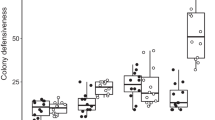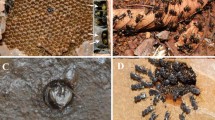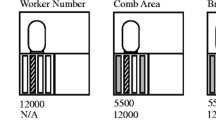Summary
Some worker honey bees respond to major disturbances of the colony by flying around the assailant and possibly stinging; they are a subset of the bees involved in colony defense. These defenders have an open-ended age distribution similar to that of foragers, but defensive behavior is initiated at a younger age than foraging is. Behavioral and genetic evidence shows that defenders and foragers are distinct groups of older workers. Behaviorally, defenders have less worn wings than foragers, suggesting less flight activity. Genetically, defenders differ in allozyme frequencies, demonstrating different subfamily composition from foragers in the same colony. They also differ in allozyme frequencies from guards in the same colony, providing further evidence for division of labor associated with colony defense. We use this information to develop a model for honey bee colony defense involving at least two distinct groups of workers and we propose that the non-guard defenders be called “soldiers”, due to their important role in colony defense.
Similar content being viewed by others
References
Adams J, Rothman ED, Kerr WE, Paulino ZL (1977) Estimation of the number of sex alleles and queen matings from diploid male frequencies in a population of Apis mellifera. Genetics 86:583–596
Boch R, Shearer DA, Stone BC (1962) Identification of iso-amyl acetate as an active component in the sting pheromone of the honey bee. Nature 202:704–706
Butler CG, Free JB (1952) The behaviour of worker honeybees at the hive entrance. Behaviour 4:262–292
Calderone NW, Page RE (1988) Genotypic variability in age polyethism and task specialization in the honey bee, Apis mellifera. Behav Ecol Sociobiol 22:17–25
Collins AM, Kubasek KJ (1982) Field test of honey bee colony defensive behavior. Ann Entomol Soc Am 75:383–387
Collins AM, Rinderer TE, Tucker KW, Sylvester HA, Lackett JJ (1980) A model of honeybee defensive behavior. J Apic Res 19:224–231
Contel EPB, Mestriner MA, Martins E (1977) Genetic control and developmental expression of malate dehydrogenase in Apis mellifera. Biochem Genet 15:859–876
Del Lama MA, Mestriner MA, Paiva JCA (1985) Esterase-5 and phosphoglucomutase-1: new polymorphisms in Apis mellifera. Rev Bras Genet 8:17–28
Free JB (1954) The behavior of robber honeybees. Behaviour 7:233–240
Free JB (1961) The stimuli releasing the stinging response of honeybees. Anim Behav 9:193–196
Free JB (1977) The social organization of the honeybees. Arnold, London
Frumhoff PC, Baker J (1988) A genetic component to division of labour with honey bee hives. Nature 333:358–361
Ghent RL, Gary NE (1962) A chemical alarm releaser in honey bee stings. Psyche 69:1–6
Kaftanoglu O, Peng YS (1980) A new syringe for semen storage and instrumental insemination of queen honeybees. J Apic Res 19:205–211
Kerr WE, Martinho MR, Goncalves LS (1980) Kinship selection in bees. Rev Bras Genet 3:339–344
Laidlaw HH (1974) Relationships of bees within a colony. Apiacta 9:49–52
Laidlaw HH, Page RE (1984) Polyandry in honey bees: sperm utilization and intracolony relationships. Genetics 108:985–997
Laidlaw HH (1977) Intrumental insemination of honey bee queens. Dadant, Hamilton, IL
Lindauer M (1961) Communication among social bees. Harvard University Press, Cambridge, MA
Moore AJ, Breed MD, Moor MJ (1987) Characterization of guard behavior in honey bees, Apis mellifera. Anim Behav 35:1159–1167
Moritz RFA (1983) Homogeneous mixing of honeybee semen by centrifugation. J Apic Res 22:249–255
Nunamaker RA, Wilson WT (1981) Comparison of MDH allozyme patterns in the African honey bee (Apis mellifera adansonii L.) and the Africanized populations of Brazil. J Kansas Entomol Soc 54:704–710
Page RE, Metcalf RA (1982) Multiple mating, sperm utilization, and social evolution. Am Nat 119:263–281
Page RE, Metcalf RA (1988) A population estimate of Mdh allozyme frequencies for the honey bee, Apis mellifera L. Pan Pacific Entomol 64:285–289
Ribbands CR (1954) The defense of the honeybee community. Proc R Soc London (B) 142:514–524
Robinson GE (1987) Regulation of honey bee age polyethism by juvenile hormone. Behav Ecol Sociobiol 20:329–338
Robinson GE, Page RE (1988a) Genetic determination of guarding and undertaking in honey bee colonies. Nature 333:356–358
Robinson GE, Page RE (1988b) Genetic structure, division of labor, and the evolution of insect societies. In: Breed MD, Page RE (eds) The genetics of social evolution. Westview Press, Boulder, CO
Robinson GE, Page RE (1989) Genetic determination of nectar foraging, pollen foraging, and nest-site scouting in honey bee colonies. Behav Ecol Sociobiol 24: 317–323
Sokal RR, Rohlf FJ (1981) Biometry. Freeman, New York
Taber S III (1954) The frequency of multiple mating of queen honey bees. J Econ Entomol 47:995–998
Taber S III, Wendell J (1958) Concerning the number of times queen bees mate. J Econ Entomol 51:786–789
Winston ML (1987) The biology of the honey bee. Harvard University Press, Cambridge, MA
Woyke J (1962) The hatchability of “lethal” eggs in a two sex allele fraternity of honeybee. J Apic Res 1:6–13
Author information
Authors and Affiliations
Additional information
Offprint requests to: M.D. Breed
Rights and permissions
About this article
Cite this article
Breed, M.D., Robinson, G.E. & Page, R.E. Division of labor during honey bee colony defense. Behav Ecol Sociobiol 27, 395–401 (1990). https://doi.org/10.1007/BF00164065
Received:
Accepted:
Issue Date:
DOI: https://doi.org/10.1007/BF00164065




